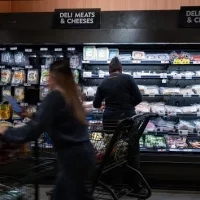
(NEW YORK) — Consumer sentiment improved more than expected in June, indicating a swell of optimism as President Donald Trump rolled back some tariffs in recent weeks.
The resurgence of shopper attitudes ended six consecutive months of worsening sentiment, University of Michigan survey data on Friday showed. Before the uptick, consumer sentiment had fallen near its lowest level since a bout of inflation three years ago.
Year-ahead inflation expectations, meanwhile, dropped sharply from 6.6% last month to 5.1% in June, the data showed. The anticipated inflation level would still mark a major increase from the current year-over-year inflation of 2.4%.
The improvement of sentiment was reflected across all demographics, including age, income, wealth, political party and geographic region, Surveys of Consumers Director Joanne Hsu said in a statement.
In recent weeks, Trump has dialed back some of his steepest tariffs, easing the costs imposed upon importers. Such companies typically pass along a share of the higher tax burden in the form of price hikes.
A trade agreement between the U.S. and China slashed tit-for-tat tariffs between the world’s two largest economies and triggered a surge in the stock market. Within days, Wall Street firms softened their forecasts of a downturn.
The U.S.-China accord came weeks after the White House paused a large swath of Trump’s “Liberation Day” tariffs targeting dozens of countries. Trump also eased sector-specific tariffs targeting autos and rolled back duties on some goods from Mexico and Canada.
Still, an across-the-board 10% tariff applies to nearly all imports, except for semiconductors, pharmaceuticals and some other items. Those tariffs stand in legal limbo, however, after a pair of federal court rulings late last month.
Tariffs remain in place for steel, aluminum and autos, as well as some goods from Canada and Mexico.
Fresh inflation data this week showed a slight acceleration of price increases, but inflation remains near its lowest level since 2021. So far, the economy has defied fears of price hikes, instead giving way to a cooldown of inflation over the months since Trump took office.
Warning signs point to the possibility of elevated prices over the coming months, however.
Nationwide retailers like Walmart and Best Buy have voiced alarm about the possibility they may raise prices as a result of the levies.
The Organization for Economic Co-operation and Development, or OECD, said this month it expects U.S. inflation to reach 4% by the end of 2025, which would mark a sharp increase from current levels.
Federal Chair Jerome Powell, in recent months, has warned about the possibility that tariffs may cause what economists call “stagflation,” which is when inflation rises and the economy slows.
Stagflation could put the central bank in a difficult position. If the Fed were to raise interest rates, it could help ease inflation, but it may risk an economic downturn. If the Fed were to cut rates in an effort to spur economic growth, the move could unleash faster price increases.
For now, the Fed appears willing to take a wait-and-see approach. At its last meeting, in May, the Fed opted to hold interest rates steady for the second consecutive time.
The Fed will announce its next rate decision on June 18. Investors peg the chances of a decision to leave rates unchanged at 99.9%, according to the CME FedWatch Tool, a measure of market sentiment.
Copyright © 2025, ABC Audio. All rights reserved.















